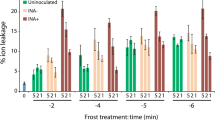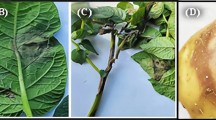Abstract
BLIGHT of celery caused by Septoria spp. was first definitely recognized in England in 1906 and afterwards was reported to spread rapidly over the country1. As early as 1910 it was known that the pycnidia of the fungus on the ‘seed’ contained spores which produced the disease when they were suspended in water and sprayed on to plants.
This is a preview of subscription content, access via your institution
Access options
Subscribe to this journal
Receive 51 print issues and online access
$199.00 per year
only $3.90 per issue
Buy this article
- Purchase on Springer Link
- Instant access to full article PDF
Prices may be subject to local taxes which are calculated during checkout
Similar content being viewed by others
References
Chittenden, F. J., Ann. App. Biol., 1, 204 (1914–15).
Mukkath, A., and Wood, R. K. S., Nature, 196, 493 (1962).
Hewett, P. D., Nature, 197, 918 (1963).
Marshall, G., Ann. App. Biol., 48, 27 (1960).
Sheridan, J. E. (in the press).
Author information
Authors and Affiliations
Rights and permissions
About this article
Cite this article
SHERIDAN, J. Infection of Celery Seedlings by Viable Spores of Septoria spp.. Nature 199, 508–509 (1963). https://doi.org/10.1038/199508b0
Issue Date:
DOI: https://doi.org/10.1038/199508b0
Comments
By submitting a comment you agree to abide by our Terms and Community Guidelines. If you find something abusive or that does not comply with our terms or guidelines please flag it as inappropriate.



